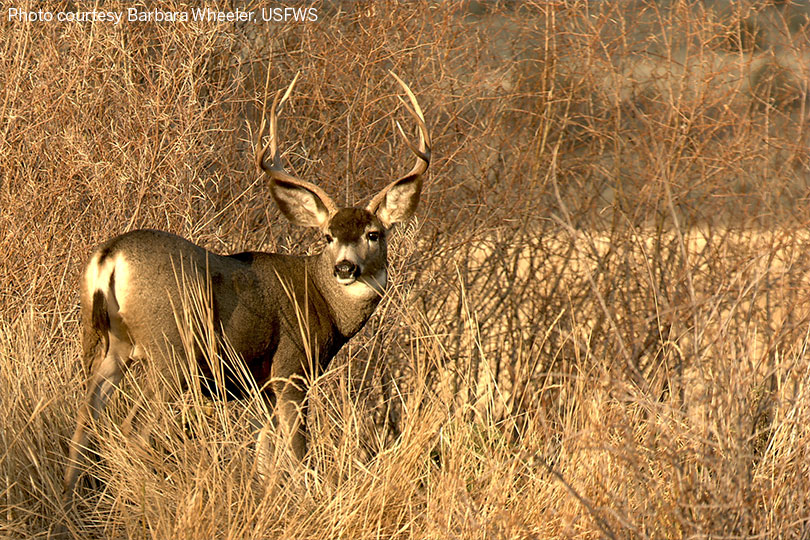By Jessica Domel
Multimedia Reporter
The archery-only mule deer hunting seasons in the Panhandle and Trans-Pecos are underway now, and the Texas Parks and Wildlife Department (TPWD) reports the drought has taken a toll.
“I would say the chances of bagging a mule deer would probably be average, but the antler production is going to be quite a bit below average just because we didn’t have any moisture during the antler development time,” Shawn Gray, TPWD mule deer and pronghorn program leader, told the Texas Farm Bureau Radio Network.
The lack of timely rains, and its impact on forages, has also affected the state’s mule deer population over the past couple of years.
“We get lower fawn crops, and so the production of the herd goes down,” Gray said. “I wouldn’t say it’s an historic decline or anything like that. It’s just the product of the current drought, but hopefully we’re going out of that.”
The average mule deer fawn crop in the Trans-Pecos and the Panhandle is 30-35%.
Gray said that’s enough to maintain the mule deer population and maybe grow it a bit.
“Both populations have natural ups and downs,” Gray said. “We don’t really want a rocketed downward trend.”
Gray said he is hopeful because recent rains have helped improve conditions in the mule deer’s range.
Body weights are expected to be good this season.
Those who plan on hunting mule deer this year should note a few regulation changes approved by the Texas Parks and Wildlife Commission.
The mule deer general season in 15 southwestern Panhandle counties has been expanded from nine to 16 days. There’s also now a special archery season there.
The commission also approved the expansion of a mule deer antler restriction that started four years ago as an experiment in seven counties in the Panhandle.
“The experiment went really well, and we wanted to expand that out into some other counties,” Gray said. “We expanded it to another 21 counties in the Texas Panhandle.”
Terrell County in the Trans-Pecos now also falls under the new restriction.
The restriction applies for the following counties: Andrews, Armstrong, Bailey, Briscoe, Castro, Childress, Cochran, Collingsworth, Cottle, Dawson, Donley, Floyd, Foard, Gaines, Hale, Hall, Hardeman, Hockley, Lamb, Lynn, Lubbock, Martin, Motley, Parmer, Randall, Swisher, Terry, Terrell and Yoakum counties.
In those counties, hunters may only harvest mule deer bucks with an outside antler spread of the main beams of 20 inches or greater.
Gray said the regulation will help maintain more natural mule deer sex ratios in those counties.
“We had quite a bit of intensive buck harvest going on in the southeast Panhandle counties. There were six counties that we tried this experiment, and then we added Lynn County in the second year,” Gray said. “It was having an impact on the sex ratio, so there was becoming a lot more does than bucks, and the buck age structure was really, really young.”
TPWD is asking hunters in Terrell County in the Trans-Pecos to bring any buck mule deer they harvest to a designated check station to help assess the experimental antler restriction in the area.
“We actually have prizes like we did in the Panhandle check stations, where we have a couple of $500 gift cards sponsored by the Mule Deer Foundation. Then, we’ll have several hundred dollar gift cards to Cabellas, and that’s from the San Angelo chapter of SEI,” Gray said.
The check station is at Stuards Deer Processing in Dryden. It’s open from 9 a.m. to 7 p.m. Nov. 25-27, Dec. 2-4 and Dec. 9-11.
Hunters are encouraged to check the Outdoor Annual, the Outdoor Annual app or Outdoorannual.com before hunting as Chronic Wasting Disease (CWD) testing is required in some areas.
The archery-only mule deer general season is open through Nov. 4.
The general season in the Panhandle opens Nov. 19. The general season in the Trans-Pecos and in Brewster, Pecos and Terrell counties follows Nov. 25.

